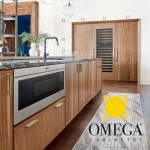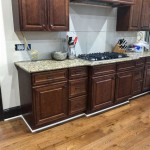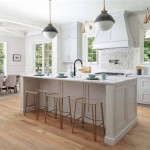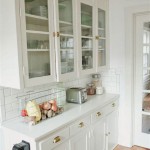1960s Kitchen Cabinets: A Retrospective Look
The 1960s represented a dynamic shift in American design, including the aesthetic and functional elements of the kitchen. Kitchen cabinets of this era reflected a move away from the post-war austerity and embraced bolder colors, new materials, and a growing emphasis on convenience and modernity. Understanding the trends in 1960s kitchen cabinets requires an examination of the prevailing design philosophies, the materials used, and the overall impact on kitchen design.
The Design Ethos of the 1960s Kitchen
The 1960s kitchen was conceived as a central hub of the home, reflecting the changing roles of women and the increasing importance of family life. This shift meant that kitchens were no longer purely utilitarian spaces; they were becoming more integrated with living areas, and their design demanded attention. Cabinets played a significant role in this transformation. The overarching design ethos focused on creating bright, cheerful, and efficient spaces. This translated into the selection of cabinet styles and finishes that were often visually stimulating and easy to clean.
The influence of mid-century modern design was also prominent. Clean lines, minimalist hardware, and a focus on functionality were hallmarks of this style. While not all kitchens adopted the full mid-century modern aesthetic, its principles heavily influenced cabinet design. This often manifested in slab doors, simple pulls, and a lack of elaborate ornamentation. The goal was to create a clean and uncluttered look that complemented the overall design of the kitchen.
Space efficiency was another key consideration. Kitchens were often designed with the housewife in mind, aiming to minimize steps and maximize storage. This led to the incorporation of innovative storage solutions within cabinets, such as pull-out shelves, lazy Susans, and pot racks. The organization of kitchen tools and ingredients was prioritized, making meal preparation more efficient and enjoyable.
Materials and Finishes of 1960s Kitchen Cabinets
The materials used in 1960s kitchen cabinets varied widely, ranging from solid wood to innovative laminates and synthetic materials. Each material offered unique advantages in terms of cost, durability, and aesthetic appeal. The choice of material often depended on the homeowner's budget and personal preferences.
Solid wood cabinets, typically made from oak, maple, or birch, remained a popular choice for those seeking a traditional look and durable construction. These cabinets were often stained in light to medium tones, emphasizing the natural grain of the wood. However, solid wood cabinets required regular maintenance to prevent warping, cracking, and staining. The higher cost and maintenance requirements made them less accessible to some homeowners.
Laminates emerged as a game-changer in the 1960s, offering a cost-effective and durable alternative to solid wood. Laminates were typically applied to particleboard or plywood substrates, providing a smooth, easy-to-clean surface that resisted scratches, stains, and moisture. They also offered a wide range of colors and patterns, allowing homeowners to customize their kitchens to their liking. Popular laminate finishes included wood grain patterns, solid colors (such as avocado green, harvest gold, and turquoise), and even textured surfaces.
Vinyl was another material increasingly used in cabinet construction and finishing. It offered similar benefits to laminates in terms of durability and ease of maintenance. Vinyl-wrapped cabinets were particularly popular, as they provided a seamless and water-resistant finish. The availability of vinyl in various colors and textures made it a versatile choice for kitchen design.
Hardware also played a crucial role in the look of 1960s kitchen cabinets. Simple, geometric pulls and knobs were common, often made of brushed chrome, stainless steel, or plastic. The hardware was typically understated, complementing the clean lines of the cabinets without drawing excessive attention. Integrated handles, which were recessed into the cabinet doors, were also popular, furthering the minimalist aesthetic.
Color Trends and Styles
Color was a defining characteristic of 1960s kitchen cabinets. In contrast to the more subdued tones of previous decades, the 1960s embraced vibrant and playful colors, reflecting the optimism and cultural shifts of the era. These colors were often used in combination, creating visually engaging and cheerful kitchen spaces.
Avocado green was perhaps the most iconic color of the 1960s kitchen. This earthy, yet vibrant, hue was used extensively on cabinets, appliances, and countertops. Its popularity stemmed from its perceived connection to nature and its ability to create a sense of warmth and comfort. Harvest gold, another warm and inviting color, was also widely used, often paired with avocado green or wood tones.
Turquoise, a bright and refreshing color, provided a stark contrast to the earthier tones of avocado green and harvest gold. It was often used as an accent color, adding a pop of vibrancy to the kitchen space. Other popular colors included sunshine yellow, poppy red, and various shades of blue. These colors were often used in combination, creating bold and playful kitchen designs.
While bold colors were prevalent, neutral tones also had their place in 1960s kitchens. White, off-white, and light gray were often used as base colors, providing a clean and versatile backdrop for colorful accents. These neutral tones also helped to lighten up smaller kitchens, making them feel more spacious and airy.
In terms of styles, slab door cabinets were particularly popular, especially in kitchens that adopted a mid-century modern aesthetic. These cabinets featured flat, unadorned doors, emphasizing clean lines and simplicity. Shaker-style cabinets, with their recessed center panels, also remained a popular choice, offering a more traditional look. Raised panel cabinets, although less common than slab or Shaker-style cabinets, were sometimes used in more formal kitchens.
Decorative details were generally kept to a minimum in 1960s kitchen cabinets. However, some cabinets featured subtle accents, such as decorative molding or metal trim. Glass-front cabinets were also used to display dishes and glassware, adding a touch of elegance to the kitchen space. Overall, the emphasis was on functionality and simplicity, with a focus on creating a clean and uncluttered look.
Impact on Kitchen Design
The trends in 1960s kitchen cabinets had a lasting impact on kitchen design. The emphasis on functionality, durability, and affordability paved the way for new materials and construction techniques that continue to be used today. The bold color palettes and playful designs of the 1960s also influenced subsequent generations of kitchen designers, inspiring them to experiment with color and create more visually engaging kitchen spaces.
The widespread adoption of laminates and vinyl revolutionized the kitchen cabinet industry, making affordable and durable cabinets accessible to a wider range of homeowners. These materials also allowed for greater design flexibility, enabling kitchens to be customized to suit individual tastes and preferences. The focus on space efficiency and innovative storage solutions also transformed the way kitchens were designed, making them more organized and user-friendly.
The integration of the kitchen with other living areas, a trend that began in the 1960s, continues to be a prominent feature of modern home design. Open-plan kitchens, which seamlessly connect to dining and living spaces, have become increasingly popular, reflecting the changing roles of the kitchen as a central hub of the home. The design of kitchen cabinets has played a crucial role in this integration, with cabinets often serving as a visual bridge between the kitchen and other areas of the house.
Key Points Summarized
Functionality and Efficiency
The design of 1960s kitchen cabinets prioritized functionality and efficiency. This was reflected in the incorporation of innovative storage solutions, the use of durable and easy-to-clean materials, and the overall focus on creating a user-friendly kitchen space.
Material Innovation
The 1960s saw the widespread adoption of new materials, such as laminates and vinyl, which offered cost-effective and durable alternatives to solid wood. These materials revolutionized the kitchen cabinet industry and allowed for greater design flexibility.
Bold Color Palettes
Color was a defining characteristic of 1960s kitchen cabinets, with vibrant hues such as avocado green, harvest gold, and turquoise taking center stage. These bold colors reflected the optimism and cultural shifts of the era and created visually engaging kitchen spaces.

1960 S Kitchen Remodel Plans The Stonybrook House

Updated 1960 S Kitchen Reveal Little Vintage Cottage

1960 S Kitchen Remodel Plans The Stonybrook House
1960s Kitchens From Jet Age To Funkadelic
1960s Kitchens From Jet Age To Funkadelic

1960s Kitchen Remodel Design
:strip_icc()/264137956_226851966251099_7445829494357355390_n-0caf797b754f411e852154344659431f.jpg?strip=all)
14 1960s Kitchen Ideas We Still Love Today

For Those Who Kept Their Old Kitchen Cabinets Pics

The Evolution Of Kitchens Through Years Between Naps On Porch
:strip_icc()/97254230_167698388039805_3219216841560390430_n-794c52725d9d420b9022143c72e741b9.jpg?strip=all)
14 1960s Kitchen Ideas We Still Love Today
Related Posts








